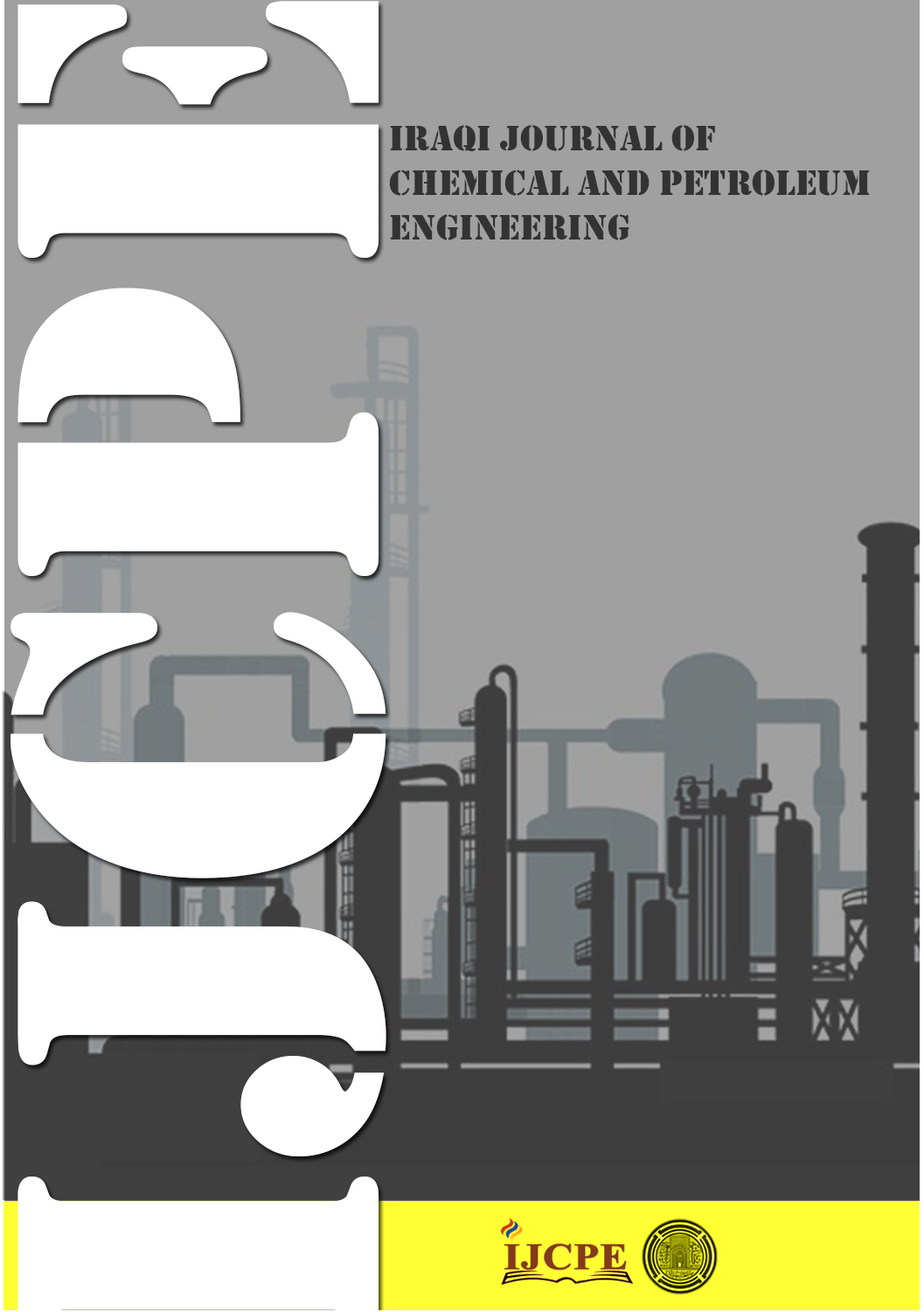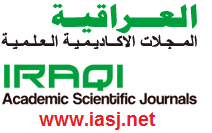Improving the elimination of methyl orange dye by combining electrocoagulation system with the adsorption process by oven-dried alum sludge: adopting different combined systems
DOI:
https://doi.org/10.31699/IJCPE.2025.3.12Keywords:
combined systems; alum sludge; electrocoagulation; Adsorption; kinetic modelAbstract
Due to their recalcitrant characteristics, Azo dyes such as methyl orange (MO) are extremely poisonous substances, making their removal from textile industry wastewater a major problem. By employing various EC-Adsorption combined system configurations and reusing alum sludge as an adsorbent, the current study seeks to investigate the efficiency of these various systems in removing MO dye. To estimate their benefits and limitations, experiments were carried out utilizing nickel foam (NiF) and aluminum plate (Al plate) as anodes, and stainless-steel mesh (SS mesh) as cathode in the presence of alum sludge as an adsorbent in all systems. The EC-Adsorption combined system with NiF as anode and two SS meshes as cathodes with 10 g/L of alum sludge in the solution, which is referenced as S3, offered 98.968% of MO dye removal efficiency within 30 minutes without the need for prolonged treatment and with very low concentration of leached Ni ions. The BET surface area, pore size, surface morphology, and composition of alum sludge were examined. The utilization of alum sludge in the combined system enhanced the removal of excess Ni ions and reduced its impact in the treated solutions, and moderately enhanced the MO dye removal efficiency. To attain a detailed explanation of the adsorption mechanism, various kinetics and isotherm models were applied. The adsorption of MO dye in the S3 EC-Adsorption system follows the intra-particle diffusion model, and the best-fit isotherm was the Freundlich isotherm.
Received on 03/06/2025
Received in Revised Form on 28/06/2025
Accepted on 06/07/2025
Published on 30/09/2025
References
[1] M. Anwar-ul-Haq, A.J. Hashmat, E. Islam, M. Afzal, A. Mahmood, M. Ibrahim, M. Nawaz, S. Nadeem, Q.M. Khan, “Pilot-Scale Electrochemical Treatment of Textile Effluent and its Toxicological Assessment for Tilapia (Oreochromis niloticus L.) Culture,” Pakistan Journal of Zoology, vol. 50, no. 5, 2018, https://doi.org/10.17582/journal.pjz/2018.50.4.1703.1708
[2] S. Khelifi, A. Choukchou-Braham, H. M. Sbihi, M. Azam, S. I. Al-Resayes, and F. Ayari, “Treatment of textile dyeing wastewater using advanced photo-oxidation processes for decolorization and cod reduction,” Desalination and Water Treatment, vol. 217, pp. 350–357, 2021, https://doi.org/10.5004/dwt.2021.26895
[3] H. Q. Ali and A. A. Mohammed, “Elimination of Congo Red Dyes From Aqueous Solution Using Eichhornia Crassipes,” Iraqi Journal of Chemical and Petroleum Engineering, vol. 21, no. 4, pp. 21–32, Dec. 2020, https://doi.org/10.31699/ijcpe.2020.4.3
[4] T. A. Aragaw, “Potential and prospects of reductases in azo dye degradation: a review,” The Microbe, vol. 4, p. 100162, Sep. 2024, https://doi.org/10.1016/j.microb.2024.100162
[5] A. Yaqub, H. Raza, H. Ajab, S. H. Shah, A. Shad, and Z. A. Bhatti, “Decolorization of reactive blue-2 dye in aqueous solution by electrocoagulation process using aluminum and steel electrodes,” Journal of Hazardous Materials Advances, vol. 9, p. 100248, Feb. 2023, https://doi.org/10.1016/j.hazadv.2023.100248
[6] I. Louati et al., “Simultaneous cleanup of Reactive Black 5 and cadmium by a desert soil bacterium,” Ecotoxicology and Environmental Safety, vol. 190, Mar. 2020, https://doi.org/10.1016/j.ecoenv.2019.110103
[7] A. T. Mohammed Ali and R. H. Salman, “Enhancing the Removal of Methyl Orange Dye by Electrocoagulation System with Nickel Foam Electrode – Optimization with Surface Response Methodology,” Journal of Ecological Engineering, vol. 25, no. 12, pp. 26–38, 2024, https://doi.org/10.12911/22998993/193587
[8] S. M. Alardhi, S. S. Fiyadh, A. D. Salman, and M. Adelikhah, “Prediction of methyl orange dye (MO) adsorption using activated carbon with an artificial neural network optimization modeling,” Heliyon, vol. 9, no. 1, Jan. 2023, https://doi.org/10.1016/j.heliyon.2023.e12888
[9] R. Al-Tohamy, S.S. Ali, F. Li, K.M. Okasha, Y.A.G. Mahmoud, T. Elsamahy, H. Jiao, Y. Fu, J. Sun, “A critical review on the treatment of dye-containing wastewater: Ecotoxicological and health concerns of textile dyes and possible remediation approaches for environmental safety,” Ecotoxicology and Environmental Safety, Feb. 01, 2022, https://doi.org/10.1016/j.ecoenv.2021.113160
[10] Q. Ye, H. Wu, J. Li, Y. Huang, M. Zhang, Q. Yi, B. Yan, “Preparation of 1,8-dichloroanthraquinone/graphene oxide/poly (vinylidene fluoride) (1,8-AQ/GO/PVDF) mediator membrane and its application to catalyzing biodegradation of azo dyes,” Ecotoxicology and Environmental Safety, vol. 268, Dec. 2023, https://doi.org/10.1016/j.ecoenv.2023.115681
[11] N. Jawad and T. M. Naife, “Mathematical Modeling and Kinetics of Removing Metal Ions from Industrial Wastewater,” Iraqi Journal of Chemical and Petroleum Engineering, vol. 23, no. 4, pp. 59–69, Dec. 2022, https://doi.org/10.31699/ijcpe.2022.4.8
[12] P. Moradihamedani, “Recent advances in dye removal from wastewater by membrane technology: a review,” Polymer Bulletin, Apr. 01, 2022, https://doi.org/10.1007/s00289-021-03603-2
[13] J. Joseph, R. C. Radhakrishnan, J. K. Johnson, S. P. Joy, and J. Thomas, “Ion-exchange mediated removal of cationic dye-stuffs from water using ammonium phosphomolybdate,” Materials Chemistry and Physics, vol. 242, Feb. 2020, https://doi.org/10.1016/j.matchemphys.2019.122488
[14] Y. N. Teixeira, F. J. de Paula Filho, V. P. Bacurau, J. M. C. Menezes, A. Zhong Fan, and R. P. F. Melo, “Removal of Methylene Blue from a synthetic effluent by ionic flocculation,” Heliyon, vol. 8, no. 10, Oct. 2022, https://doi.org/10.1016/j.heliyon.2022.e10868
[15] C. Zaharia, C. P. Musteret, and M. A. Afrasinei, “The Use of Coagulation–Flocculation for Industrial Colored Wastewater Treatment—(I) The Application of Hybrid Materials,” Applied Sciences, Mar. 01, 2024, https://doi.org/10.3390/app14052184
[16] Ö. Gökkuş, E. Brillas, and I. Sirés, “Sequential use of a continuous-flow electrocoagulation reactor and a (photo)electro-Fenton recirculation system for the treatment of Acid Brown 14 diazo dye,” Science of the Total Environment, vol. 912, Feb. 2024, https://doi.org/10.1016/j.scitotenv.2023.169143
[17] R. N. Abbas and A. S. Abbas, “Kinetics and Energetic Parameters Study of Phenol Removal from Aqueous Solution by Electro-Fenton Advanced Oxidation Using Modified Electrodes with PbO2 and Graphene,” Iraqi Journal of Chemical and Petroleum Engineering, vol. 23, no. 2, pp. 1–8, Jun. 2022, https://doi.org/10.31699/ijcpe.2022.2.1
[18] Q. H. Nguyen, T. Watari, T. Yamaguchi, Y. Takimoto, K. Niihara, J.P. Wiff, T. Nakayama, “COD removal from artificial wastewater by electrocoagulation using aluminum electrodes,” International Journal of Electrochemical Science, vol. 15, no. 1, pp. 39–51, Jan. 2020, https://doi.org/10.20964/2020.01.42
[19] P. V. Nidheesh, M. Zhou, and M. A. Oturan, “An overview on the removal of synthetic dyes from water by electrochemical advanced oxidation processes,” Chemosphere, vol. 197, pp. 210–227, Apr. 2018, https://doi.org/10.1016/j.chemosphere.2017.12.195
[20] H. J. Nsaif, N. S. Majeed, and R. H. Salman, “Preparation of nano SnO2-Sb2O3composite electrode by cathodic deposition for the elimination of phenol by Sonoelectrochemical oxidation,” Polish Journal of Chemical Technology, Sep. 2024, https://doi.org/10.2478/pjct-2024-0026
[21] S. H. Ammar, N. N. Ismail, A. D. Ali, and W. M. Abbas, “Electrocoagulation technique for refinery wastewater treatment in an internal loop split-plate airlift reactor,” Journal of Environmental Chemical Engineering, vol. 7, no. 6, Dec. 2019, https://doi.org/10.1016/j.jece.2019.103489
[22] T. Kim, T. K. Kim, and K. D. Zoh, “Removal mechanism of heavy metal (Cu, Ni, Zn, and Cr) in the presence of cyanide during electrocoagulation using Fe and Al electrodes,” Journal of Water Process Engineering, vol. 33, Feb. 2020, https://doi.org/10.1016/j.jwpe.2019.101109
[23] J. Liu, W. Jiang, G. Wang, L. Zhang, Y. Chen, and R. Xin, “Experimental study on removal of emulsified oil by electrocoagulation with a rotating container,” International Journal of Electrochemical Science, vol. 14, no. 6, pp. 5122–5131, Jun. 2019, https://doi.org/10.20964/2019.06.47
[24] K. Gautam, S. Kamsonlian, and S. Kumar, “Removal of Reactive Red 120 dye from wastewater using electrocoagulation: optimization using multivariate approach, economic analysis, and sludge characterization,” Separation Science and Technology (Philadelphia), vol. 55, no. 18, pp. 3412–3426, Dec. 2020, https://doi.org/10.1080/01496395.2019.1677713
[25] T. Jovanović, N. Velinov, M. Petrović, S. Najdanović, D. Bojić, M. Radović, A. Bojić, “Mechanism of the electrocoagulation process and its application for treatment of wastewater: A review,” Advanced Technologies, vol. 10, no. 1, pp. 63–72, 2021, https://doi.org/10.5937/savteh2101063j
[26] Y. J. Liu, S. L. Lo, Y. H. Liou, and C. Y. Hu, “Removal of nonsteroidal anti-inflammatory drugs (NSAIDs) by electrocoagulation-flotation with a cationic surfactant,” Separation and Purification Technology, vol. 152, pp. 148–154, Aug. 2015, https://doi.org/10.1016/j.seppur.2015.08.015
[27] S. C. M. Signorelli, J. M. Costa, and A. F. de Almeida Neto, “Electrocoagulation-flotation for orange II dye removal: Kinetics, costs, and process variables effects,” Journal of Environmental Chemical Engineering, vol. 9, no. 5, Oct. 2021, https://doi.org/10.1016/j.jece.2021.106157
[28] N. A. Salleh, S. Kheawhom, and A. A. Mohamad, “Characterizations of nickel mesh and nickel foam current collectors for supercapacitor application,” Arabian Journal of Chemistry, vol. 13, no. 8, pp. 6838–6846, Aug. 2020, https://doi.org/10.1016/j.arabjc.2020.06.036
[29] K. Muthumanickam and R. Saravanathamizhan, “Electrochemical treatment of dye wastewater using nickel foam electrode,” Journal of Electrochemical Science and Engineering, vol. 11, no. 3, pp. 209–215, 2021, https://doi.org/10.5599/jese.1011
[30] H. H. Thwaini and R. H. Salman, “Modification of Electro-Fenton Process with Granular Activated Carbon for Phenol Degradation – Optimization by Response Surface Methodology,” Journal of Ecological Engineering, vol. 24, no. 9, pp. 92–104, 2023, https://doi.org/10.12911/22998993/168411
[31] F. Sher, S.Z. Iqbal, T. Rasheed, K. Hanif, J. Sulejmanović, F. Zafar, E.C. Lima, “Coupling of electrocoagulation and powder activated carbon for the treatment of sustainable wastewater,” Environmental Science and Pollution Research, vol. 28, no. 35, pp. 48505–48516, Sep. 2021, https://doi.org/10.1007/s11356-021-14129-5
[32] P. Twizerimana and Y. Wu, “Overview of integrated electrocoagulation-adsorption strategies for the removal of heavy metal pollutants from wastewater,” Discover Chemical Engineering, vol. 4, no. 1, Jun. 2024, https://doi.org/10.1007/s43938-024-00053-w
[33] N. S. Graça and A. E. Rodrigues, “The Combined Implementation of Electrocoagulation and Adsorption Processes for the Treatment of Wastewaters,” Clean Technologies, Dec. 01, 2022, https://doi.org/10.3390/cleantechnol4040063
[34] M. A. Tantawy, “Characterization and pozzolanic properties of calcined alum sludge,” Materials Research Bulletin, vol. 61, pp. 415–421, 2015, https://doi.org/10.1016/j.materresbull.2014.10.042
[35] R. Liu, Y. Zhao, C. Sibille, and B. Ren, “Evaluation of natural organic matter release from alum sludge reuse in wastewater treatment and its role in P adsorption,” Chemical Engineering Journal, vol. 302, pp. 120–127, Oct. 2016, https://doi.org/10.1016/j.cej.2016.05.019
[36] Y. Yang, Y. Zhao, R. Liu, and D. Morgan, “Global development of various emerged substrates utilized in constructed wetlands,” Bioresource Technology, Aug. 01, 2018, Elsevier Ltd. https://doi.org/10.1016/j.biortech.2018.03.085
[37] N. Muisa, I. Nhapi, W. Ruziwa, and M. M. Manyuchi, “Utilization of alum sludge as adsorbent for phosphorus removal in municipal wastewater: A review,” Journal of Water Process Engineering, Jun. 01, 2020, Elsevier Ltd. https://doi.org/10.1016/j.jwpe.2020.101187
[38] T. Ahmad, K. Ahmad, and M. Alam, “Characterization of Water Treatment Plant’s Sludge and its Safe Disposal Options,” Procedia Environmental Sciences, vol. 35, pp. 950–955, 2016, https://doi.org/10.1016/j.proenv.2016.07.088
[39] P. Devi and A. K. Saroha, “Utilization of sludge based adsorbents for the removal of various pollutants: A review,” Science of The Total Environment, Feb. 01, 2017, Elsevier B.V. https://doi.org/10.1016/j.scitotenv.2016.10.220
[40] Q. Hou, P. Meng, H. Pei, W. Hu, and Y. Chen, “Phosphorus adsorption characteristics of alum sludge: Adsorption capacity and the forms of phosphorus retained in alum sludge,” Materials Letters, vol. 229, pp. 31–35, Oct. 2018, https://doi.org/10.1016/j.matlet.2018.06.102
[41] M. Kasina, M. Wendorff-Belon, P. R. Kowalski, and M. Michalik, “Characterization of incineration residues from wastewater treatment plant in Polish city: a future waste based source of valuable elements?,” Journal of Material Cycles and Waste Management, vol. 21, no. 4, pp. 885–896, Jul. 2019, https://doi.org/10.1007/s10163-019-00845-1
[42] M. A. Tony, “Zeolite-based adsorbent from alum sludge residue for textile wastewater treatment,” International Journal of Environmental Science and Technology, vol. 17, no. 5, pp. 2485–2498, May 2020, https://doi.org/10.1007/s13762-020-02646-8
[43] F. Benaissa, H. Kermet-Said, and N. Moulai-Mostefa, “Optimization and kinetic modeling of electrocoagulation treatment of dairy wastewater,” Desalination Water Treat, vol. 57, no. 13, pp. 5988–5994, Mar. 2016, https://doi.org/10.1080/19443994.2014.985722
[44] Y. Liu, C. Li, J. Bao, X. Wang, W. Yu, and L. Shao, “Degradation of Azo Dyes with Different Functional Groups in Simulated Wastewater by Electrocoagulation,” Water (Switzerland), vol. 14, no. 1, Jan. 2022, https://doi.org/10.3390/w14010123
[45] A. Abbas Najim and A. A. Mohammed, “Biosorption of Methylene Blue from Aqueous Solution Using Mixed Algae,” Iraqi Journal of Chemical and Petroleum Engineering, vol. 19, no. 4, pp. 1–11, Dec. 2018, https://doi.org/10.31699/ijcpe.2018.4.1
[46] G. S. Aljeddani, R. M. Alghanmi, and R. A. Hamouda, “Study on the Isotherms, Kinetics, and Thermodynamics of Adsorption of Crystal Violet Dye Using Ag-NPs-Loaded Cellulose Derived from Peanut-Husk Agro-Waste,” Polymers (Basel), vol. 15, no. 22, Nov. 2023, https://doi.org/10.3390/polym15224394
[47] P. Twizerimana and Y. Wu, “Overview of integrated electrocoagulation-adsorption strategies for the removal of heavy metal pollutants from wastewater,” Discover Chemical Engineering, vol. 4, no. 1, Jun. 2024, https://doi.org/10.1007/s43938-024-00053-w
[48] S. Irki, D. Ghernaout, and M. W. Naceur, “Decolourization of methyl orange (MO) by electrocoagulation (EC) using iron electrodes under a magnetic field (MF),” Desalination and Water Treatment, vol. 79, pp. 368–377, Jun. 2017, https://doi.org/10.5004/dwt.2017.20797
[49] M. Kul, K.O. Oskay, F. Erden, E. Akça, R. Katirci, E. Köksal, E., Akinci, “Effect of process parameters on the electrodeposition of zinc on 1010 Steel: Central composite design optimization,” International Journal of Electrochemical Science, vol. 15, pp. 9779–9795, 2020, https://doi.org/10.20964/2020.10.19
[50] H. N. M. Ekramul Mahmud, A. K. Obidul Huq, and R. B. Yahya, “The removal of heavy metal ions from wastewater/aqueous solution using polypyrrole-based adsorbents: A review,” RSC Advances, 2016, https://doi.org/10.1039/c5ra24358k
[51] A. M. Aljeboree, A. F. Alkaim, and A. H. Al-Dujaili, “Adsorption isotherm, kinetic modeling and thermodynamics of crystal violet dye on coconut husk-based activated carbon,” Desalination and Water Treatment, vol. 53, no. 13, pp. 3656–3667, Mar. 2015, https://doi.org/10.1080/19443994.2013.877854
[52] K. O. Iwuozor, J. O. Ighalo, E. Chizitere Emenike, C. Adaobi Igwegbe, and A. G. Adeniyi, “Do adsorbent pore size and specific surface area affect the kinetics of methyl orange aqueous phase adsorption?,” Journal of Chemistry Letters, vol. 2, pp. 188–198, 2021, https://doi.org/10.22034/JCHEMLETT.2022.327407.1048
[53] M. Sabharwal and M. Secanell, “Understanding the effect of porosity and pore size distribution on low loading catalyst layers,” Electrochimica Acta, vol. 419, Jul. 2022, https://doi.org/10.1016/j.electacta.2022.140410
[54] M. Musah, Y. Azeh, J. Mathew, M. Umar, Z. Abdulhamid, and A. Muhammad, “Adsorption Kinetics and Isotherm Models: A Review,” Caliphate Journal of Science and Technology, vol. 4, no. 1, pp. 20–26, Feb. 2022, https://doi.org/10.4314/cajost.v4i1.3
[55] S. I. Al-Saeedi, A. Areej, M.T. Qamar, A. Alhujaily, S. Iqbal, M.T. Alotaibi, M. Aslam, M.A. Qayyum, A., Bahadur, N.S. Awwad, Y. Jazaa, E.B. Elkaeed, “Isotherm and kinetic studies for the adsorption of methylene blue onto a novel Mn3O4-Bi2O3 composite and their antifungal performance,” Frontiers in Environmental Science, vol. 11, 2023, https://doi.org/10.3389/fenvs.2023.1156475
[56] K. A. Babatunde, B. M. Negash, S. R. Jufar, T. Y. Ahmed, and M. R. Mojid, “Adsorption of gases on heterogeneous shale surfaces: A review,” Journal of Petroleum Science and Engineering, Jan. 01, 2022, Elsevier B.V. https://doi.org/10.1016/j.petrol.2021.109466
[57] Y. Wang, Y. Zhu, S. Liu, and R. Zhang, “Pore characterization and its impact on methane adsorption capacity for organic-rich marine shales,” Fuel, vol. 181, pp. 227–237, Oct. 2016, https://doi.org/10.1016/j.fuel.2016.04.082
[58] S. Mustapha, D.T. Shuaib, M.M. Ndamitso, M.B. Etsuyankpa, A. Sumaila, U.M. Mohammed, M.B., Nasirudeen, “Adsorption isotherm, kinetic and thermodynamic studies for the removal of Pb(II), Cd(II), Zn(II) and Cu(II) ions from aqueous solutions using Albizia lebbeck pods,” Applied Water Science, vol. 9, no. 6, Aug. 2019, https://doi.org/10.1007/s13201-019-1021-x
[59] G. S. Aljeddani, R. M. Alghanmi, and R. A. Hamouda, “Study on the Isotherms, Kinetics, and Thermodynamics of Adsorption of Crystal Violet Dye Using Ag-NPs-Loaded Cellulose Derived from Peanut-Husk Agro-Waste,” Polymers (Basel), vol. 15, no. 22, Nov. 2023, https://doi.org/10.3390/polym15224394
Downloads
Published
Issue
Section
License
Copyright (c) 2025 The Author(s). Published by College of Engineering, University of Baghdad.

This work is licensed under a Creative Commons Attribution 4.0 International License.













